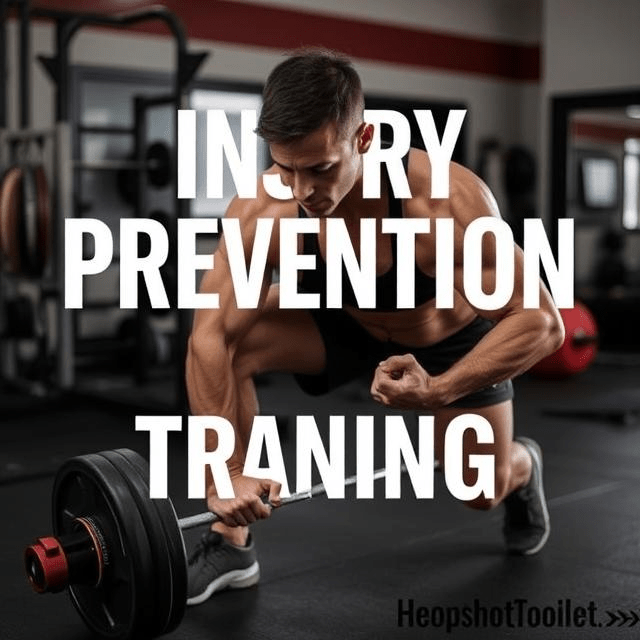
We all get injured, from time to time. In this post we will be covering Injury prevention for strength training. We’ll be taking a look at the mistakes people make while weight training.
The data shows a high proportion of us are unaware of how we should conduct ourselves to avoid injuries. In this post you will discover what you should be doing, to ensure your strength training workouts are productive.
Injury Prevention For Strength Training
Did you know that nearly 50% of gym-related injuries are caused by improper technique or poor programming? Injury prevention for strength training isn’t optional, it’s essential if you want to stay consistent, healthy, and progressing.
Strength training isn’t just about lifting heavy; it’s about doing it right. Imagine building a tower. The bricks need to lay straight and solid. Same with your body during a workout. Each movement needs proper form to handle the load without cracking up.
Whether you’re a beginner or a seasoned lifter, injuries can set you back weeks or worse, cause long-term issues. This guide will help you lift smarter, not just harder.

Why Injury Prevention For Strength Training Matters
The goal of strength training is to build a stronger, more resilient body, not to break it down. But without the right precautions, it’s easy to overload joints, strain muscles, or cause chronic pain. Injury prevention isn’t just a side topic; it’s the foundation of effective training.
Warm-Up and Cool Down – The Unsung Heroes
Warming up is like starting your car on a chilly morning. Muscles are similar: they need that gentle start to work efficiently without getting a hitch. A good warm-up increases blood flow, activates muscle groups, and preps your nervous system.
Tips for an effective warm-up:
- 5-10 minutes of light cardio (e.g., jogging or cycling)
- Dynamic stretches targeting the muscles you’ll train.
- Gradual sets with lighter weights before your main lifts.
Cooling down post-workout is equally important. It helps ease your body back into a resting state, reduces soreness, and promotes recovery. Think: light walking, static stretching, or foam rolling.
Form First – Technique Over Ego
Lifting heavier weights feels amazing, but only if your form supports it. Just like a leaning tower will fall, bad lifting mechanics will catch up with you.
Common form mistakes to avoid:
- Rounding the back during deadlifts.
- Letting knees cave inward on squats.
- Using momentum instead of controlled movement.
Recording your lifts or working with a coach can make a huge difference. Good form ensures the right muscles do the work, and keeps joints safe.
Listen to Your Body – Pain Is a Signal, Not a Challenge
Your body often sends signals, but we’re experts at ignoring them, right? Feeling a twinge when bending your arm might mean you’re pushing too hard. Paying attention to what hurts can stop a small issue from becoming a big problem.
If something feels off:
- Stop and assess the pain.
- Consider modifying or skipping that exercise.
- Consult a professional if it persists.
Don’t push through sharp or lingering pain. Strength training should be challenging, not punishing.
Balanced Programming – Avoiding the Overload Trap
Getting into a routine is wonderful, but balance is everything. Ever tried piling on too many bricks on one side of a tower? It tips. Balance your sets, reps, intensity, and training volume.
Injury Prevention For Strength Training Begins With Smart Programming
Think of your workout program like a well-structured novel. Each chapter (or week) builds on the last. Progressive overload should be gradual and logical, not a sudden leap in weight or intensity.
Include variety and structure:
- Push-pull balance in your weekly split.
- Rotating intensity levels (e.g., de-load weeks)
- Proper rest intervals between workouts.
To avoid common gym injuries, strength training injury prevention should include rest, cross-training, and mobility work alongside weightlifting.
Building a Structured Plan – Practical Strategies for Safety and Progression
Crafting your strength training plan is like plotting a road trip. No one wants to run out of gas halfway, right? Strength gains and safety come from a program that recognizes where you’re at now, not just where you want to be. Tailor your plan to keep intensity in check with your abilities and goals.
Gradual Progress – The Key to Staying Injury-Free
Think of adding weight gradually like reading a series of books. You don’t jump from a kids’ book to a PhD thesis overnight, you progress. Slowly increasing weight lets your muscles grow stronger and adapt without the nasty side effects of surprise strains.
Strength training safety also includes setting realistic goals and avoiding “no pain, no gain” mindsets that often lead to preventable injuries.

Rest, Recovery, and Fuel – Your Secret Weapons
Rest isn’t just doing nothing, it’s essential for growing stronger. Those rest days and active recovery moments? Treat them like VIPs. Giving your muscles time to repair means they come back firing on all cylinders.
Fuelling Strength and Preventing Injury Through Nutrition
What you eat and drink plays a huge part, too. Hydration and nutrition are key players in keeping injuries at bay. Balanced meals and plenty of fluids provide the fuel for your muscles to perform and recover well.
Quick nutrition tips:
- Eat a mix of protein, carbs, and healthy fats.
- Stay hydrated before, during, and after workouts.
- Consider supplements like magnesium or collagen if needed.
Injury Prevention For Strength Training – Final Takeaways
To get the most out of your strength training journey, safety must come first. That doesn’t mean going soft, it means training smart. With proper form, balanced programming, smart progression, and attention to recovery, you’ll build strength that lasts a lifetime.
Remember:
- Warm up and cool down every time
- Prioritize form over ego
- Respect pain and signals from your body
- Progress slowly and wisely
- Recover and refuel properly
Stay consistent, stay smart and keep lifting. Try to make every training session productive and more importantly safe. Please leave any other tips or ideas below.
Ultimate Training Gear.






